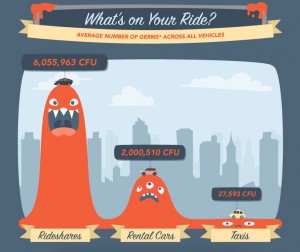Rental cars are often considered almost throw away items. We’ve all heard the old axiom: People will do things in a rental car that they won’t do in their own. According to new testing, that’s not true: ride-hailing vehicles – typically owned by the driver – are the grossest thing on four wheels.
Insurance aggregator Netquote recently conducted tests to see just how nasty some modes of transport can be, specifically, taxi cabs, rental cars and ride-hailing cars. While many would have put money on the taxi being the most disgusting, those vehicles are subject to rules, including cleanliness.
What vehicles aren’t? Yup. Ride-hailing vehicles.
Netquote swabbed the seatbelt, door handle and window buttons of three randomly picked taxis and three ride-hailing vehicles, and did the same to the steering wheel, gearshift and seatbelt of three rental cars — the touch points are different on a rental drive than on a hailed ride. The samples were sent to a lab for testing, the results were provided as colony-forming unit numbers, or CFU.
(Ride-hailing services don’t cut traffic, they add to it. Click Here for the story.)
After getting the results back, the last two letters may be what you utter before getting into an Uber, Lyft or Waymo anytime soon.
The ride-hailing vehicles came back with more than 6 million CFU/sq. in. while the rental car showed up with about 2.5 million CFU/sq. in. and the taxi was shockingly clean compared to the others at 27,000 CFU/sq. in.
What does this mean in real terms? Well, a typical bathroom toilet seat would have around 171 CFU/sq. in. A coffeemaker is pretty nasty at 32,000 CFU/sq. in., but it’s the toothbrush holder that takes the cake at more than 2 million CFU/sq. in. Not all of the found germs are bad for you, but the more there are, the bigger the likelihood that some might be downright nasty for your health.
(Click Here for details about Lyft’s IPO depending on an autonomous future.)
The three rental cars yielded CFU levels of more than 1 million, both on steering wheels and gear levers. Seatbelts were nearly toilet clean in comparison, with just 403 CFU/sq. in. It goes from bad to unbelievably gross when ride-hailing vehicles are involved, starting with an average of 5 million CFU/sq. in. on the window controls and more than 1 million on seatbelts, with the door handles comparably clean at 1,810 CFU/sq. in. on average.
It’s also important to note that the presence of germs doesn’t necessarily equate to a dangerous situation, but the fact that they are there and in large numbers increases the odds of something — unpleasant.
(To check out more about Waymo’s plans to build driverless vehicles in Detroit, Click Here.)
As far as bacteria type breakdowns, 50% of the germs found in rental cars were gram-positive cocci and 50% were gram-negative rods. Taxis yielded 65% gram-positive cocci, 29% gram-negative rods, and 5% yeast. Ride-hailing vehicles hosted the most equal distribution of germs: 34% bacilli, 33% gram-negative rods, 16.5% gram-positive rods, and 16.5% yeast. So what to do? Wipe down those vehicles and bring hand sanitizer.


I think it reflects on the type of person using these different modes of transportation. Taxis and rental cars are used by more affluent people and RideShare by millennials who live in their parents basements and depend on their Mothers to clean up after them (if they are allowed in the basement).